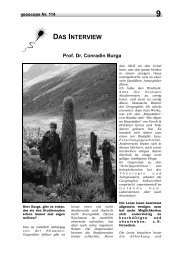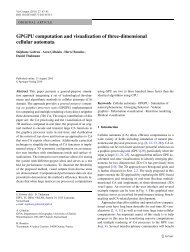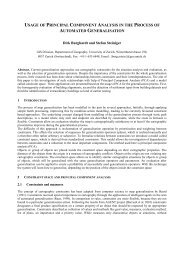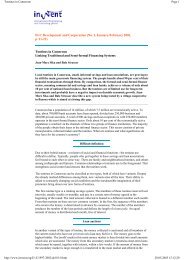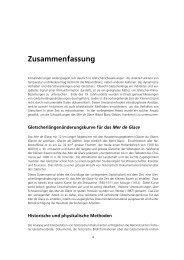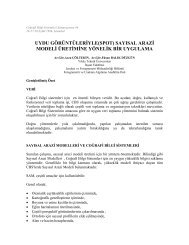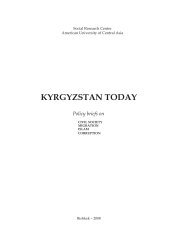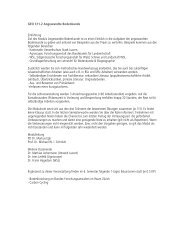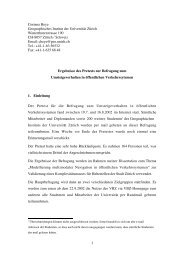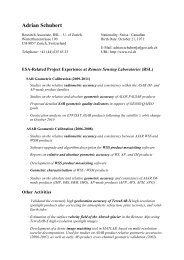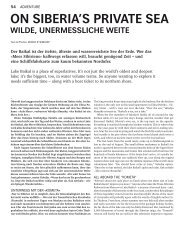Pedogenesis of Chernozems in Central Europe — A review
Pedogenesis of Chernozems in Central Europe — A review
Pedogenesis of Chernozems in Central Europe — A review
Create successful ePaper yourself
Turn your PDF publications into a flip-book with our unique Google optimized e-Paper software.
Holocene (c. 11500–5500 BP; Pre-Boreal to Atlantic) when<br />
warmer climate and forest vegetation dom<strong>in</strong>ated the <strong>Central</strong><br />
<strong>Europe</strong>an loess-belt.<br />
The purpose <strong>of</strong> this <strong>review</strong> is to highlight the most important<br />
literature on <strong>Chernozems</strong> <strong>in</strong> <strong>Central</strong> <strong>Europe</strong> published s<strong>in</strong>ce the<br />
1920s. We did not discuss the Russian <strong>Chernozems</strong>, because<br />
this would exceed the limits <strong>of</strong> this paper. We also exluded black<br />
soils formed with a steady water supply, like Gleyic<br />
<strong>Chernozems</strong> and Gleyic or Stagnic Phaeozems. In this <strong>review</strong>,<br />
we want to discuss the follow<strong>in</strong>g questions: (1) What is the<br />
def<strong>in</strong>ition <strong>of</strong> <strong>Chernozems</strong>, and (2) where do we f<strong>in</strong>d them? (3)<br />
When did <strong>Central</strong> <strong>Europe</strong>an <strong>Chernozems</strong> form, and (4) is their<br />
formation bound to a certa<strong>in</strong> climate and vegetation? (5) Which<br />
factors control conservation and degradation <strong>of</strong> <strong>Chernozems</strong>?<br />
(6) Are there unconsidered factors that <strong>in</strong>fluence Chernozem<br />
formation or their soil properties?<br />
We focus on different soil form<strong>in</strong>g factors potentially<br />
dom<strong>in</strong>at<strong>in</strong>g the pedogenesis <strong>of</strong> <strong>Chernozems</strong> <strong>in</strong> <strong>Central</strong> <strong>Europe</strong>,<br />
i.e. time, vegetation, climate and, potentially overlooked so far,<br />
fire and man. We want to po<strong>in</strong>t out that there is no generally<br />
accepted consensus on the formation <strong>of</strong> <strong>Chernozems</strong> <strong>in</strong> <strong>Central</strong><br />
<strong>Europe</strong>.<br />
E. Eckmeier et al. / Geoderma 139 (2007) 288–299<br />
2. What is a Chernozem? Def<strong>in</strong>itions and systematics<br />
The World Reference Base for Soil Resources (FAO/ISRIC/<br />
ISSS, 1998) def<strong>in</strong>ed <strong>Chernozems</strong> as soils with mollic or chernic<br />
horizons <strong>of</strong> at least 20 cm and with a chrome <strong>of</strong> ≤2 for substrate<br />
f<strong>in</strong>er than sandy loam or ≤3.5 for sandy loam or coarser<br />
substrate, respectively. <strong>Chernozems</strong> should conta<strong>in</strong> concentrations<br />
<strong>of</strong> secondary carbonates start<strong>in</strong>g with <strong>in</strong> 50 cm <strong>of</strong> the<br />
lower limit <strong>of</strong> the A horizon but at least with<strong>in</strong> the top 200 cm,<br />
they should lack a petrocalcic horizon or secondary gypsum<br />
between a depth <strong>of</strong> 25 and 100 cm, and their diagnostic horizons<br />
are no other then argic, vertic or calcic. There should be no<br />
uncoated silt and sand gra<strong>in</strong>s on the structural ped surfaces.<br />
Usually, the dark mollic A horizon is situated on an argic or<br />
cambic B horizon. The mollic horizons are rich <strong>in</strong> organic<br />
matter (10–16%), are highly saturated with bases and react<br />
neutral. Typical features <strong>of</strong> <strong>Chernozems</strong> are the formation on<br />
mostly aeolian and carbonaceous sediments like loess, the<br />
occurrence <strong>in</strong> cont<strong>in</strong>ental climate under tall-grass vegetation<br />
that provides high above-ground biomass <strong>of</strong> about 1.0–1.5 t<br />
ha − 1 , and an <strong>in</strong>tense bioturbation shown by krotov<strong>in</strong>as (animal<br />
burrows) (FAO/ISRIC/ISSS, 1998; Driessen et al., 2001).<br />
Fig. 1. <strong>Central</strong> <strong>Europe</strong>an <strong>Chernozems</strong> and related soils as described <strong>in</strong> the German pedological literature. The Chernozem (‘Tschernosem’) has a dark mollic horizon<br />
and could have stagnic or gleyic properties. The latter do not appear <strong>in</strong> areas with lower water net balance, here secondary carbonates become more frequent. Increas<strong>in</strong>g<br />
precipitation and leach<strong>in</strong>g leads to the development <strong>of</strong> first Haplic, then Cambic and Luvic <strong>Chernozems</strong> and f<strong>in</strong>ally Luvic Phaeozems (‘Tschernosem–Parabraunerde’).<br />
Some soils have properties that fit to the Chernozem def<strong>in</strong>ition, with the exception that their mollic horizon is greyish and not dark brownish to black (‘Grauerden’;<br />
term is not recognised <strong>in</strong> the <strong>of</strong>ficial German classification). These grey soils can conta<strong>in</strong> secondary carbonates (calcic) or can have gleyic or stagnic properties and<br />
were assigned to the Phaeozems. Luvisols (‘Parabraunerde’) develop af ter stronger leach<strong>in</strong> g and translocation <strong>of</strong> clay.<br />
289






